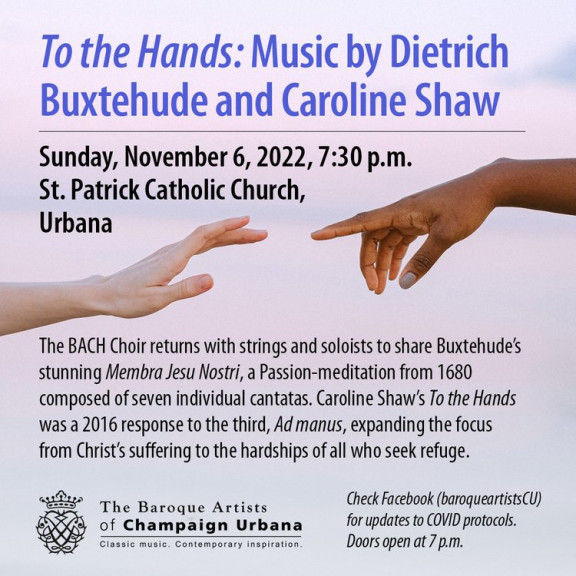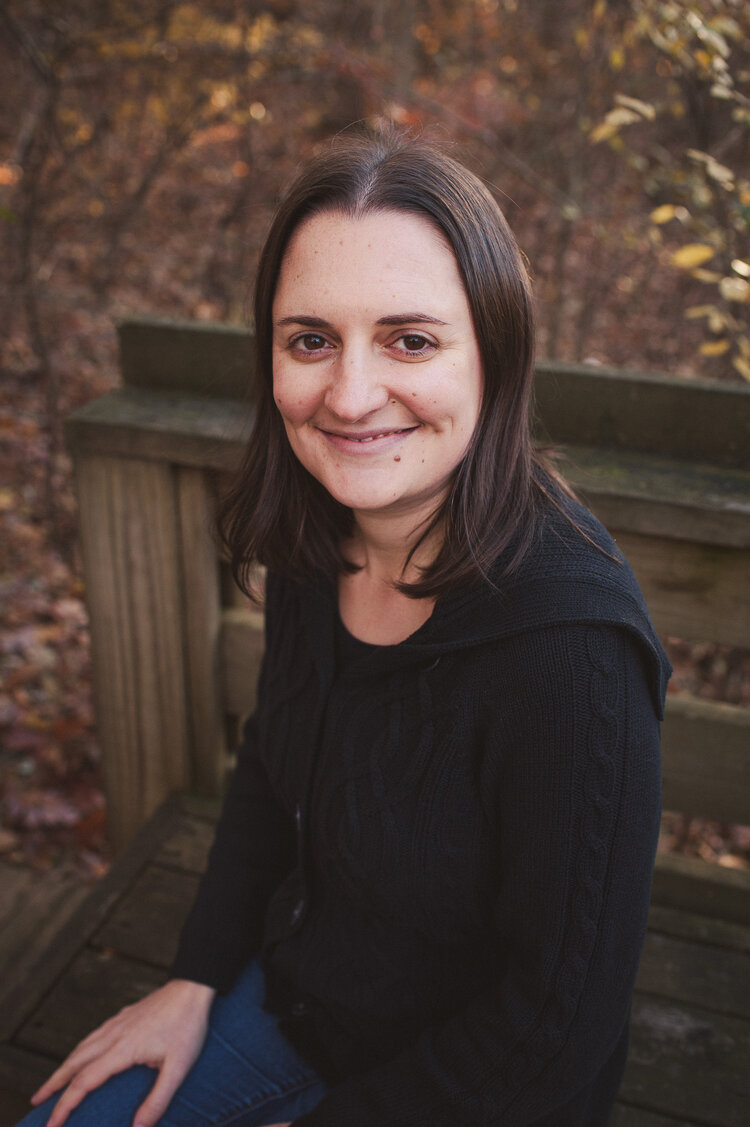Conversation with BACH Music Director Dr. Sarah Riskind

On Sunday, November 6, the Baroque Artists of Champaign-Urbana (BACH) will present a program featuring Dietrich Buxtehude’s 1680 Passion-meditation, Membra Jesu Nostri, a cycle of seven cantatas that contemplate a different part of the crucified Christ’s body: his feet, knees, hands, side, breast, heart, and face. This will be paired with To the Hands, contemporary composer Caroline Shaw’s response to the third cantata, Ad manus.
Composed in 2016, Shaw’s To the Hands grows out of the musical language of Buxtehude, but it expands the focus from Christ’s suffering to that of the whole world, specifically those who seek refuge. The first half of the program will include the first three cantatas of Membra Jesu Nostri, followed by To the Hands so the audience can hear the musical connections between it and the cantata on which it is based. The final four cantatas of Membra Jesu Nostri will comprise the second half.
We sat down with Dr. Sarah Riskind, the music director of BACH, to learn more about this fascinating program.

Music Director of BACH Dr. Sarah Riskind
Katie Buzard: How did the idea for this program come about? Have you performed either or both of these pieces before?
Dr. Sarah Riskind: I have wanted to program Buxtehude’s Membra Jesu Nostri ever since I reviewed the Duke Vespers Ensemble’s recording for Choral Journal in 2017. This early Baroque work is full of poignant choruses, solos, and sonatas in minor keys, with some sweet and intimate major moments such as the Ad ubera portabimini chorus. In each of the seven cantatas that make up this work, Buxtehude develops a few melodic motives in a satisfying way, leaving them running through my head after I've been listening to or rehearsing the work. I particularly love the dissonances he uses at cadences when each voice part moves at a different time; this makes the resolution even more rewarding.
I first heard Caroline Shaw's To the Hands performed live by the Chicago Chamber Choir at the Midwestern American Choral Directors Association Conference last February. It struck me as a profoundly moving work, with meaningful connections to the Buxtehude cantata by which it was inspired. Since one of my primary goals as the Music Director of BACH is to use Baroque music as a foundation for exploring a more diverse collection of works, I resolved to build a program out of these two deeply connected pieces separated by 336 years.
KB: What do you think pairing To the Hands with Membra Jesu Nostri adds to the listener’s experience or understanding of the 17th-century work?
SR: The Buxtehude invites the listener to contemplate Jesus Christ’s suffering on the cross as a sacrifice to save humankind. We can imagine that churchgoers in Lübeck hearing these cantatas in the 1680s might respond strongly to the text and musical style, since it was the music of their time and was intended to be part of the liturgy.
In this day and age, church music takes many forms—and works such as the Buxtehude are just as often presented in a concert setting. In a concert, we want to reach audience members with many different worldviews, religious beliefs, and musical backgrounds. Caroline Shaw’s To the Hands draws on this theme of suffering and the image of Jesus’ hands to reflect on the suffering of those around the world seeking refuge, as well as the succor that they yearn to find at the end of their journeys. The needs for a welcoming home, a community, and freedom from oppressors are what we all share, however we frame this (or don’t frame this) in the context of religious beliefs. As a Jewish choral conductor with a passion for early music, I am accustomed to connecting with Christian musical works on a musical and metaphorical level, but I also seek out opportunities to give our audiences multiple paths of connection.
KB: For those who are familiar with Caroline Shaw’s Pulitzer Prize-winning work Partita for 8 Voices, how does the vocal and compositional style of To the Hands compare with that of Partita? Do you find it lends itself well to a community choir context?
SR: To the Hands offers many new musical and conceptual ideas, but I can name a number of stylistic connections to her Partita: the spoken components appear in “V. Litany” in To the Hands (in this case, a tragically high number of displaced individuals from many countries around the world), the consonant but unexpected series of triads appear in “III. Her Beacon-Hands,” the well-placed silences appear throughout the work, the rich parallel tenor–bass moments appear in “III. Her Beacon-Hands” and elsewhere, and rhythmic complexity appears in “IV. Ever Ever...”
It is more suited to a community choir than Partita because it doesn’t ask for as many varied vocal techniques. Roomful of Teeth, for which she composed the Partita, specializes in techniques such as belting, overtone singing, yodeling, and more. I will add that Roomful of Teeth was founded by my wonderful undergraduate conducting mentor Brad Wells shortly after I graduated from Williams College, so I was following the ensemble closely around the time Caroline Shaw won the Pulitzer and later when Roomful of Teeth won their Grammy! In fact, I met Caroline at a post-concert party in the Boston area and found out about her Pulitzer a few months later... (Roomful of Teeth also sang my Hanukkah canon “Hanerot Halalu” at the Guggenheim in December 2019, and their vocal versatility added some powerful nuance!)
KB: More generally, what is your approach to programming for BACH and why? Last June, for instance, you performed rarely heard works by Italian cloistered nuns. Is it part of your mission to consistently incorporate works by women and others from traditionally underrepresented groups in your concerts?
SR: With every ensemble I conduct, which currently includes two choirs and an instrumental group at Eureka College in addition to the Baroque Artists of Champaign-Urbana, I aim to include music by traditionally underrepresented groups as a matter of course. I believe that this is something we conductors need to work hard at achieving, and it is a continuous journey of learning and adjusting our practices. Fortunately, there is a vast amount of early music by women and composers of color that is now being discovered, edited, and shared with the global musical community! Particularly since 2020, scholars and performers have been accelerating their efforts in this respect, though some certainly more than others.
In the 2021–2022 season, I expanded on the Song of Songs texts in Bach’s Cantata 140 Wachet auf with other settings from the Renaissance to the present, including 16th-century nuns, living Black American composers, and living Jewish composers and arrangers. Our winter concert focused on Latin American composers, from 20th-century Modesta Bor to a Renaissance European-style hymn in the Quechua language family. Our spring concert of convent music included music composed only by women (though we did include one non-nun in the program).
This season, our concert on March 5, 2023, will feature Francesco Durante’s Magnificat alongside the midwestern premiere of my Oz Cantata, with high school musicians from our Young Baroque Artists Competition and singers from local schools. The June 4 concert, “The Three Bs,” questions the idea of how we choose which composers to venerate from history, and we will share stunning music by Harry T. Burleigh (19th-century Black American composer), Margaret Bonds (20th-century Black American composer), and Lili Boulanger (20th-century French composer).
You can catch To the Hands: Music by Dietrich Buxtehude and Caroline Shaw on Sunday, November 6, at 7:30 p.m. at St. Patrick’s Catholic Church in Urbana. See here for ticket information.



